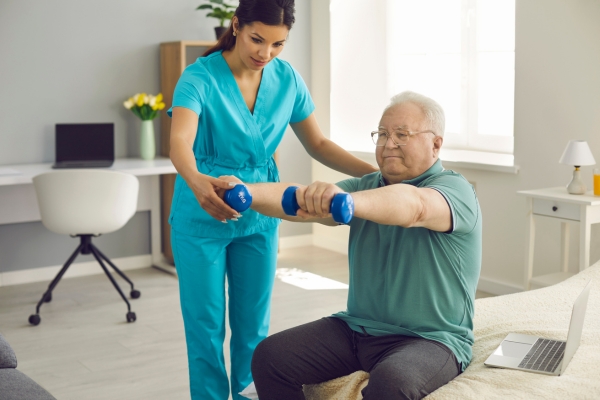Table of Content
- Introduction
- Understanding what Is Tennis Elbow?
- What Causes Tennis Elbow?
- When to Start Physio Exercises
- Benefits of Physiotherapy for Tennis Elbow
- Safe Physio Exercises to Begin With
- Progression: Intermediate to Advanced Exercises
- Tips for Doing Physio Exercises Safely
- Physiotherapy at Home vs Clinic-Based Care
- Choosing the Right Physiotherapy Services
- How Go Run Go Physio Can Help
- Frequently Asked Questions
- Conclusion
Introduction
Ongoing pain around the outside of your elbow can make even the simplest tasks feel difficult. Turning a doorknob, lifting a kettle, or using a computer mouse may all become uncomfortable if you’re dealing with tennis elbow.
This condition, caused by overuse of the forearm muscles and tendons, is both common and frustrating. Recovery can be slow without the right approach but certain movements can make a noticeable difference.
Targeted physio exercises are often used by professionals to help reduce pain, improve mobility, and strengthen the surrounding muscles without putting the joint under stress. Whether you’re following a personalised program through physiotherapy services or looking for gentle movements to begin at home, the right exercises can support healing and help prevent the problem from returning.
Starting with the right technique and progressing safely can play a valuable role in long-term recovery.
Understanding what Is Tennis Elbow?
Tennis elbow, medically called lateral epicondylitis, refers to inflammation or microtears in the tendons that attach to the outer part of your elbow. These tendons connect your forearm muscles to the bone and are responsible for movements like gripping and lifting.
Despite its name, most people with tennis elbow don’t play tennis. It can affect anyone who repetitively uses their forearm muscles.
What Causes Tennis Elbow?

Several common movements and habits can contribute to the development of tennis elbow:
- Repetitive wrist and arm motions (e.g., typing, painting, gardening)
- Poor posture or ergonomic setup
- Overuse during sports or manual work
- Lack of adequate muscle recovery
- Improper lifting techniques
These repetitive activities can strain the tendons, especially the extensor carpi radialis brevis, leading to pain and reduced function.
When to Start Physio Exercises
Physio exercises should begin only once acute inflammation and pain have reduced. If your elbow is swollen or extremely sore to touch, rest and ice application may be more appropriate for the first few days. Always consult a physiotherapist before starting.
Signs you’re ready to begin:
- Pain has decreased slightly with rest
- Basic daily movements feel manageable
- You can move your wrist without severe discomfort
Benefits of Physiotherapy for Tennis Elbow
Professional physiotherapy services can significantly shorten recovery time and reduce the risk of re-injury. Some core benefits include:
- Guided progression through safe movements
- Hands-on techniques like massage or dry needling
- Custom advice for work or sport-specific recovery
- Monitoring progress and preventing overuse
Patients who receive physiotherapy home service often benefit from tailored routines that match their surroundings and daily challenges.
Safe Physio Exercises to Begin With
Starting with light and controlled movements can help support recovery from tennis elbow by improving flexibility, reducing stiffness, and slowly rebuilding forearm strength. These six physio exercises are safe for most individuals in the early stages of healing.
1. Forearm Table Glide
Target: Improves forearm mobility and tendon glide
- Sit at a table with your affected arm resting palm-down
- Slowly slide your hand forward across the table as far as comfortable
- Keep your elbow and shoulder relaxed
- Hold for 3 seconds, then return to the starting position
- Perform 10–15 repetitions
2. Gentle Hand Press
Target: Activates wrist extensors without movement
- Sit with your forearm resting on your thigh or table
- Place your other hand gently over the back of the recovering hand
- Push upwards lightly while resisting with the top hand (no actual movement occurs)
- Hold for 5 seconds, then relax
- Repeat 10 times
3. Elbow Slide and Hold
Target: Encourages elbow range of motion
- Sit beside a smooth table surface
- Place your hand on a cloth or towel
- Slide the hand forward by straightening the elbow slowly
- Hold at full extension for 5 seconds, then return
- Perform 10–12 repetitions
4. Finger Fan and Squeeze
Target: Promotes controlled grip strength
- Start with your hand open, fingers spread apart
- Slowly bring all fingers together to make a gentle fist
- Hold for 3 seconds
- Reopen and repeat 10–15 times
- Avoid clenching too tightly
5. Overhead Reach with Palm Rotation
Target: Supports shoulder and elbow alignment and gentle forearm rotation
- Raise your affected arm overhead slowly
- As you lift, rotate your palm from facing you to facing away
- Lower your arm in reverse motion
- Repeat 8–10 times while maintaining a slow pace
6. Light Resistance Sponge Squeeze
Target: Builds gentle forearm engagement
- Hold a soft sponge or small towel in your affected hand
- Squeeze gently and hold for 5 seconds
- Relax fully between repetitions
- Complete 2 sets of 10 reps
These exercises are designed to reduce stiffness, promote tendon health, and restore mobility gradually. They’re especially useful for individuals receiving physiotherapy at home through trusted providers like Go Run Go Physio, where personalised guidance ensures exercises are performed safely.
Tips for Doing Physio Exercises Safely
- Start slow – avoid rushing into heavier loads
- Never force a movement if it causes sharp pain
- Perform exercises on both arms for balance
- Keep wrists neutral to reduce strain
- Stay consistent – daily small effort leads to results
- Consider consulting a physiotherapy Melbourne expert or booking a physiotherapy home service for tailored guidance
Physiotherapy at Home vs Clinic-Based Care
| Feature | Physiotherapy at Home | Clinic-Based Physiotherapy |
| Convenience | High – saves travel time | Requires travel |
| Equipment availability | May be limited | Full access to rehab tools |
| Personalised attention | One-on-one in-home sessions | One-on-one, but in clinical setting |
| Comfort | Familiar environment | More professional setup |
For some patients, especially those with limited mobility or tight schedules, physiotherapy at home may be ideal.
Choosing the Right Physiotherapy Services
Not all physiotherapy services are the same. Look for providers that:
- Offer tailored recovery plans
- Have experience with elbow and sports injuries
- Provide physiotherapy home service if needed
- Offer follow-up and ongoing support
- Are local and trusted (e.g., Go Run Go Physio)
A personalised approach leads to better recovery outcomes and lowers the risk of recurrence.
How Go Run Go Physio Can Help
Go Run Go Physio offers evidence-based rehabilitation programs for patients across Australia. Whether you’re recovering from a sports injury, work-related condition, or overuse issue like tennis elbow, their team can help you regain strength and confidence through:
- One-on-one physiotherapy sessions
- Customised physio exercises plans
- Home-based physiotherapy sessions for added convenience
- Education on preventing future flare-ups
Their qualified therapists understand the demands of day-to-day life and will guide you through safe, progressive treatment.
Frequently Asked Questions
Q1. What causes tennis elbow and who is at risk?
Answer: Tennis elbow is often caused by repetitive wrist and arm movements. It’s common in tradespeople, office workers, and athletes.
Q2. How long does it take to recover using physio exercises?
Answer: Recovery time varies, but many people improve in 6–12 weeks with consistent physio exercises and professional guidance.
Q3. Can I do physio exercises at home safely?
Answer: Yes, with proper instruction. Begin with low-resistance exercises and consult a physiotherapist if you’re unsure.
Q4. Do I need equipment for tennis elbow physiotherapy exercises?
Answer: Many starter exercises use body weight or light objects like towels and dumbbells. As you progress, resistance bands and grip tools may help.
Q5. Are home physiotherapy services as effective as clinic visits?
Answer: Yes. For many conditions, including tennis elbow, home sessions provide personalised attention in a comfortable setting.
Q6. Should I stop using my arm completely during recovery?
Answer: No. Total rest may lead to stiffness. Instead, modify activities and incorporate guided physio exercises.
Q7. What if my pain gets worse during the exercises?
Answer: Stop immediately and consult your physiotherapist. Pain should not increase with proper physio exercises.
Conclusion
Tennis elbow can limit your ability to work, exercise, and enjoy daily activities but it doesn’t have to. The right physio exercises, performed regularly and correctly, can restore strength, reduce discomfort, and prevent future flare-ups.
Whether you’re receiving in-clinic care or accessing physiotherapy home service, it’s important to follow a structured program tailored to your condition. With expert support from services like Go Run Go Physio, you can move forward with confidence and less pain

